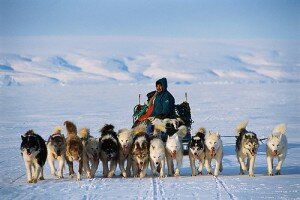
As global warming thins the arctic ice, moving with sled dogs is becoming increasingly dangerous for the Inuit people. Source: Flickr
Unstable ice, difficulties in hunting seals, migration of fish, thawing permafrost… These are some of the problems encountered by the Arctic indigenous people. As they live in a very extreme region, adaptation has been a necessity for years, but the recent acceleration of the ice melting is threatening their culture and very way of life.
Until a few years ago, the Inuit population used eight different seasons to describe the variations of the climate, today they only use four.
The Inuit population is not learning about climate change in books or during conferences – people living near the North Pole just have to look around to see the threats global warming have on their everyday life.
“Continuous adaptation is really the core of what it means to be Inuit. We have always been adjusting our diet from year to year, depending on our annual harvest, and it has helped my people to survive throughout the years,” said Aqqaluk Lynge, President of ICC Greenland, at the ‘Beyond Kyoto’ conference today.
However, as global temperatures continue to rise the Inuit people may be facing a greater need for changes than they have ever seen before.
The ice is becoming so thin and unstable that the hunting and fishing of seals, caribous and fish – that account for an important part of their daily diet – is more and more complicated. Some species of fish migrate up north, looking for cold waters. The hunting season has to be postponed, as the water needs more time to freeze than in the past. Moreover, moving with sled dogs is becoming dangerous. Thawing permafrost can cause buildings and roads to collapse and the soil is becoming unstable, which is worrying for the widespread stilt houses.
Uncertainty for the future generations
However, global warming also poses a cultural problem to this population. Many adults have a precise and detailed knowledge about their environment. They are used to understanding the rhythms and cycles of nature. But the transfer of knowledge from one generation to the next is threatened as nature becomes increasingly unpredictable and moving on the ice becomes more dangerous. Children won’t be able to live as their parents did, and it is not just a culture but also customs, a language and a way of life that are at stake and could begin to disappear.
A balance between adaptation and preservation
Recently, scientists have established that temperatures in the Arctic are rising faster than the global average. And the ice is melting more rapidly than previously predicted, with longer ice-free periods during summer.
The Inuit population will have to go on adapting itself to this rapidly changing environment. However, Aqqaluk Lynge insists that this adaption must include preservation of the Inuit’s cultural heritage.
“It is important to find a balance between new knowledge and respect for our ancient traditions and wisdom,” he says.
Lynge is open to partnerships with different countries and to a transfer of technologies and innovations to ease necessary adaptation, but adds that “the best answers are not always found in new innovations. Sometimes, it is useful to use our own methods and to look at what has worked in the past.”
By Fiona Collienne


Recent comments